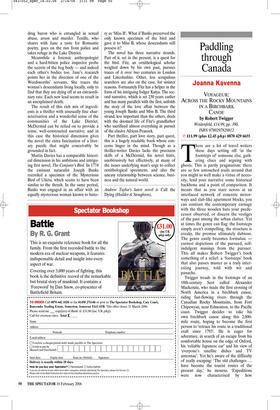Ancient trails and quests
Andrew Taylor
THE GRAVE TATTOO by Val McDermid HarperCollins, £17.99, pp. 467, ISBN 0007142854 ✆ £14.99 (plus £2.45 p&p) 0870 429 6655 THE CONJURER’S BIRD by Martin Davies Hodder, £10, pp. 320, ISBN034092053X ✆ £8 (plus £2.45 p&p) 0870 429 6655 Val McDermid is probably best known for her series of sharply contemporary thrillers featuring a criminal profiler. But some of her standalone novels, in particular the superb A Place of Execution and The Distant Echo, have narrative sections that hark back to a generation earlier; and their plots turn upon the long shadows thrown forward by past crimes. The Grave Tattoo takes this process even further back in time.
At the heart of the story is the intriguing historical link between the families of William Wordsworth and Fletcher Christian. The two men were schoolfellows, taught by Fletcher’s elder brother. There is a persistent legend that the chief mutineer of the Bounty faked his own death in the South Seas and returned to live and die in the Lake District. What if the two men had talked? What if Wordsworth had seized on Christian’s account of the mutiny and turned it into an epic poem?
These tantalising speculations underlie the plot of The Grave Tattoo. Freak summer weather brings to the surface of a Lakeland bog a long-buried and well-preserved body. The corpse’s skin has tattoos characteristic of the South Seas. (McDermid does a very good corpse, incidentally.) Simultaneously Jane Gresham, a struggling Wordsworth scholar, finds supporting documentary evidence of a possible lost poem suppressed by the poet’s family after his death. She moves back to her family’s Fellhead farm to pursue her research.
Jane’s ex-boyfriend, a manuscript expert who has sold out to sex and mammon, is also on the trail, and so are assorted academics. A Wordsworth poem based on the mutiny could be worth millions of pounds as well as confer enormous scholarly kudos. A sub-plot involves Jane’s protégée Tenille, teenage daughter of a London drug baron who is entangled in sexual abuse, arson and murder. Tenille, who shares with Jane a taste for Romantic poetry, goes on the run from police and takes refuge in the Lake District.
Meanwhile a forensic anthropologist and a hard-bitten police inspector probe the secrets of the bog body — and indeed each other’s bodies too. Jane’s research points her in the direction of one of the Wordsworths’ servants. She traces the woman’s descendants living locally, only to find that they are dying off at an extraordinary rate. Each new lead seems to result in an unexplained death.
The result of this rich mix of ingredients is a thriller with unusually fine characterisation and a wonderful sense of the communities of the Lake District. McDermid can be relied on to provide a tense, well-constructed narrative; and in this case the historical dimension gives the novel the extra fascination of a literary puzzle that might conceivably be grounded in fact.
Martin Davies has a comparable historical dimension in his ambitious and intriguing first novel, The Conjurer’s Bird. In 1774 the eminent naturalist Joseph Banks recorded a specimen of the Mysterious Bird of Ulieta, which seems to have been similar to the thrush. In the same period, Banks was engaged in an affair with an equally mysterious woman known to histo ry as ‘Miss B’. What if Banks preserved the only known specimen of the bird and gave it to Miss B, whose descendants still possess it?
The novel has three narrative strands. Part of it, set in the present, is a quest for the bird. Fitz, an ornithological scholar weighed down by his own past, pursues traces of it over two centuries in London and Lincolnshire. Other, less scrupulous searchers are also on the case, for sinister reasons. Fortunately Fitz has a helper in the form of his intriguing lodger Katya. The second narrative, which is set 230 years earlier and has many parallels with the first, unfolds the story of the love affair between the young Joseph Banks and Miss B. The third strand, less important than the others, deals with the doomed life of Fitz’s grandfather who sacrificed almost everything in pursuit of the elusive African Peacock.
Part thriller, part love story, part quest, this is a hugely readable book whose concerns linger in the mind. Though as a thriller-writer Davies lacks the precision skills of a McDermid, his novel hints, unobtrusively but effectively, at many of the issues underlying man’s urge to collect ornithological specimens, and also the uneasy relationship between science, business and the natural world.



















































































 Previous page
Previous page